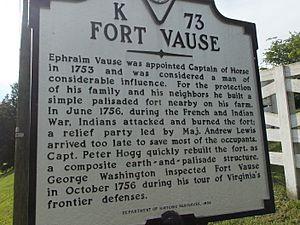Ephraim Vause facts for kids
Ephram Vause (1718–1774) was an important pioneer in what is now southwestern Virginia. A fort, named Fort Vause, was built and named after him in the area of modern-day Shawsville, Virginia. His name has been spelled in many ways, like Vause, Voss, Vaus, Vass, and Vaux.
Life of Ephram Vause
Ephram Vause originally came from a large farm in Evesham, New Jersey. In 1738, he married Theodosia Hewlings (also known as Hulings) in Philadelphia. They had six children together: Thomas (born around 1740), William (born May 7, 1741), Edward (born around 1743), Elizabeth Deliz "Livicee" (born around 1745), Levi (born around 1748), and Abner (born around 1758).
In 1743, Ephram Vause placed a notice about a lost or stolen horse. He offered a reward of fifty shillings for its safe return.
Life in Virginia
When he moved to Virginia, Ephram Vause became a well-known person in his community. In 1750, he helped with the inventory of a neighbor's property after they passed away. He was also responsible for keeping a part of the county road in good condition.
By 1754, Vause owned a large amount of land, about 620 acres. This land covered most of what is now Shawsville, Virginia. On his property, he grew crops like corn and wheat. He also raised cattle and horses. His home was a substantial house with clapboard siding. He was even building a grist mill, which is a mill for grinding grain.
Ephram Vause had people working for him, including some enslaved individuals. In June 1756, Shawnee warriors attacked his property. They took two of his household members and killed some of his cattle to feed their advancing war parties. These war parties were led by François-Marie Picoté de Belestre.
The Attack on Fort Vause
During the Shawnee attack on Fort Vause, Ephram Vause's home was burned down. His livestock were either killed or ran away. His wife, daughters, and some servants were taken captive. This event ruined his dream of building a fortune on the frontier.
After the attack, Ephram Vause sold all his land in Virginia. He then moved to Pennsylvania, where he lived until after the American Revolution.
One of Ephram Vause's daughters, Levicee, was taken by the Shawnee during the attack. She later returned after a peace treaty was signed in 1763. As she was carried along, she marked her name on the trunks of beech and sycamore trees. This is how the Levisa Fork river got its name.
Ephram Vause passed away in Russell County, Virginia.
Further Reading
- Givens, Lula Porterfield. Highlights in the Early History of Montgomery County, Virginia. [Christiansburg, Va.]: Givens, 1975.
- Goode, Eddie. Fortifying the Frontier: Ephraim Vause & Fort Vause of Augusta County, Virginia 1755-1758. Charlottesville, Va: Virginia Foundation for the Humanities and Public Policy, 2002.
- Quinlan, Patricia H. The Story of Peter Looney: His Year with the Indians. New York: iUniverse, Inc, 2009.


